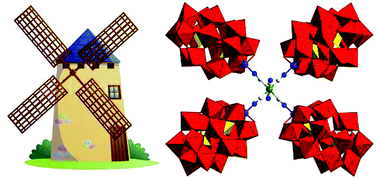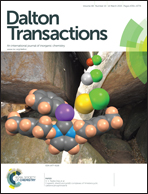Assembly of cyanometalate-functionalized phosphotungstates with magnetic properties and bifunctional electrocatalytic activities†
Abstract
Two cyanometalate-functionalized heteropolytungstates (C4H10ON)23[HN(CH2CH2OH)3]11H[FeIII(CN)6(α2-P2W17O61NiII)4]·31H2O (1) and (C4H10ON)23[HN(CH2CH2OH)3]10H2[FeIII(CN)6(α2-P2W17O61CoII)4]·27H2O (2) (C4H10ON = morpholine, HN(CH2CH2OH)3 = triethanol amine) have been successfully synthesized in aqueous solution under conventional reaction conditions, which demonstrated that it is a successful strategy to incorporate the cyanometalate fragment into lacunary heteropolytungstates. These polyanions were characterized by single-crystal X-ray diffraction, IR spectra, elemental analysis, thermogravimetric analysis, magnetic studies, and electrochemistry. Interestingly, the electrochemical studies have shown that the two complexes have bifunctional electrocatalytic activities towards not only the reduction of potassium iodate (KIO3) ascribed to the function of POM, but also the oxidation of the biological molecule ascorbic acid (AA) ascribed to the Fe-center in [MII4FeIII(CN)6]5+. Significantly, the magnetic investigations demonstrate the presence of ferromagnetic exchange interactions in 1 (Ni4Fe) and antiferromagnetic interactions in 2 (Co4Fe).


 Please wait while we load your content...
Please wait while we load your content...